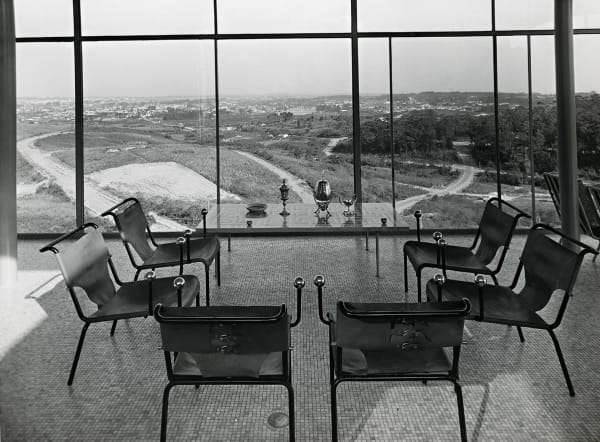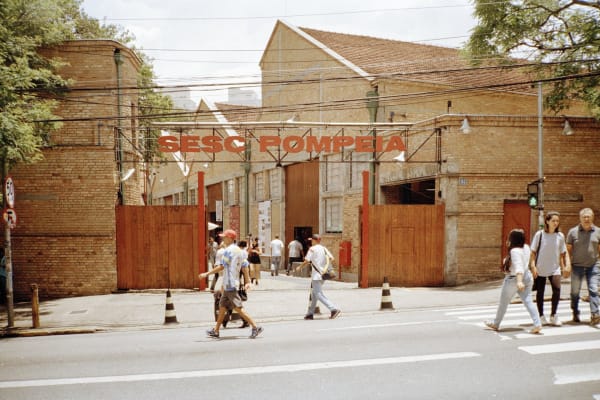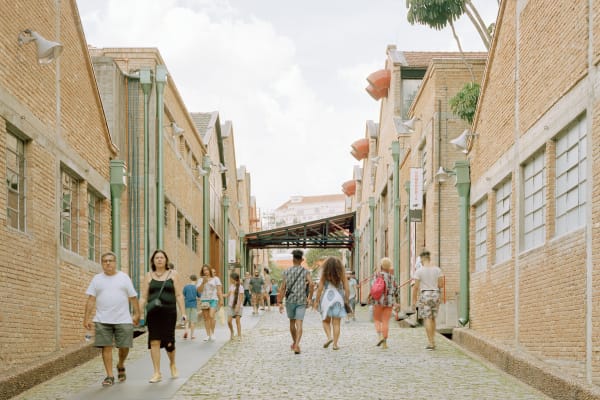-
Lina Bo Bardi, architecture and design:democratizing modern ideas through the industry
-
Lina Bo Bardi (1914-1992) believed in the industry as a vehicle for democratizing modern ideas and promoting the social and cultural potentials of architecture and design. Effortlessly combining industrialized production with sensible solutions, Bo Bardi's furniture, like her general practice, was playful and accessible yet deeply rooted in the history of modernism and design. That way, she brought Brazilian culture, territory, and history into her creations.
After designing a folding chair for the Masp auditorium in 1947, she developed in partnership with Giancarlo Palanti (1906-1977) a series of furniture based on the serial principles, saving materials and reducing production time in the Studio de Arte Palma (1948). The innovative creations of this period involved using plywood cut in the furniture design with the exposed layers – which until then was common only for structural use. This short-time experience lasted only one year, but it was a mark in Brazilian design history. -
This attempt to make furniture of good design accessible to many people didn't work as expected. Thus, from the middle 1950s, Lina focused on developing pieces with simple techniques and materials linked to her architectural projects.
THE GLASS HOUSE
The Glass House, considered an icon of modern Brazilian architecture, is the first built project by the architect Lina Bo Bardi and was the residence of Lina and Pietro Maria Bardi for over 40 years. Since its inauguration in 1952, the house has been a meeting point for artists, architects, and intellectuals.
The place works today as the headquarters of Instituto Bardi / Casa de Vidro, opened to the public as a space to preserve and perpetuate the thought and many essential works developed by the Bardi couple in life. -
-

Edition No. 10 of Habitat magazine, with pictures of the Glass House on the cover.
-

Lina Bo Bardi on the stairs of the Glass House. Photo: Instituto Bardi.
-

Lina Bo Bardi at the Glass House window. Photo: Francisco Albuquerque/Instituto Bardi.
-

Exterior view of the Glass House amidst the neighborhood's vegetation. Photo: Instituto Bardi.
-

Interior of the main hall of the Glass House. Photo: Instituto Bardi.
-

Living room at Casa de Vidro with a view of the neighborhood. Photo: Instituto Bardi.
-

Lina Bo Bardi and pet cats in the garden of the Glass House. Photo: Instituto Bardi.
-

Main entrance to the Glass House Photo: Peter Scheier/Instituto Bardi.
-
-
The site chosen to construct the house was Morumbi, a neighborhood in the South Zone of São Paulo – formerly Jardim Morumby. The two lots purchased by the couple are one of the most elevated areas in the region, with a strong presence of vegetation originating from the Atlantic Rainforest.
Her initial drawings, from 1949, revealed the building's main points: the striking presence of the glass and the natural external landscape mixing with the interiors, filled with objects and works of art. Besides the architectural project, Lina designed most of the furniture pieces present in the house. -
The multiple blue details on the floor, columns, and furniture contribute to an ethereal atmosphere that blends into the horizon. That's the case of this simple stool designed by Lina, which is sometimes used as a seat and sometimes as a side table.
The Glass House was mentioned in several critical architectural vehicles as an example of impeccable modern construction. -
-

The Glass House. Photo: Jules Villbrandt, 2019
-

The Glass House, furnished with pieces designed by Lina Bo Bardi. Photo: Jules Villbrandt, 2019
-

The Glass House, furnished with pieces designed by Lina Bo Bardi. Photo: Jules Villbrandt, 2019
-

The Glass House, furnished with pieces designed by Lina Bo Bardi. Photo: Jules Villbrandt, 2019
-
-
THE SESC POMPEIA
The Sesc Pompeia is a set of buildings in the Pompeia neighborhood in São Paulo, Brazil, that works as a cultural and sports center, with a theater, ateliers, library, exhibition areas, auditorium, and open spaces that are a refuge in an agitated metropolis.
The property where Sesc Pompeia is was built in 1938 by the German firm Mauser & Cia Ltda. to work as a factory, following a project within the English production mold from the beginning of the century. In the following years, other companies used the buildings for industrial purposes, such as the drum manufacturer Ibesa which bought the property in 1945.
The project came intending to revitalize the old abandoned factory, resignifying its function from a labor objective focused on production and profits to economically unproductive ones dedicated to culture, well-being, and leisure. Undoubtedly, a clever insight by Bo Bardi and her collaborators, André Vainer and Marcelo Carvalho Ferraz. -
The warehouses' restoration process occurred from 1977 to 1982, and the sports block was inaugurated a few years later, in 1986. Bo Bardi led the architectural project of restoration and readjustment of the buildings and also in many other areas – the workflow of cultural activities developed in the space, the graphic design and visual communication, employee uniforms design, and the furniture pieces, which we will detail further below.
In 2021, the project was elected as one of the 25 most important post-war architectural works by The New York Times. The architect and photographer Ciro Miguel is the author of the recent photos in this article, part of his continuous series of Everyday Photos. -
THE SESC POMPEIA STOOL
THE SESC POMPEIA STOOL
The iconic Sesc Stool was designed by Lina Bo Bardi between 1979 and 1982, especially for Sesc Pompeia. The stools should compose the living areas, such as the dining hall and the library. A version of this design is also in the theater. -
 Sesc Pompeia. Photo: Ciro Miguel
Sesc Pompeia. Photo: Ciro Miguel -
The Sesc Stool is structured with only four thick rectangular blocks of plywood pine, different from the traditional thin layers of laminated wood or plywood. The material had been developed by the engineer Vinicio Walter Callia (1923–1994) as a construction material to be used in architectural structures. The stools were manufactured by SESC carpenters using plywood produced by Laminarco, Callia’s company. The pieces are built in a simplified manner that resembles crates, with a single decorative detail: a cutout in a "U" shape on the backrest.
The Bardi Institute archive has many sketches by Bo Bardi of the stool's design process, showing different construction variations, especially concerning the feet construction. SESC Pompeia has the right to restore and replace the furniture pieces for use in public spaces – Lina designed it for this purpose.
-
Bo Bardi's vast cultural production and critical texts shared that there's no universal solution for architecture and design problems; each needs to respond to the local circumstances and society. Besides the Sesc Pompeia Stool, Bo Bardi also designed other furniture pieces for the building. The Instituto Bardi's Archives has many sketches with tables, sofas, lighting objects, desks, and cabinets.
-
-

Desk, sketch by Lina Bo Bardi, 1977. Image: Instituto Bardi
-

Modulated sofa, sketch by Lina Bo Bardi, 1977. Image: Instituto Bardi
-

Cabinet, sketch by Lina Bo Bardi, 1977. Image: Instituto Bardi
-

Tiles for the pool, sketch by Lina Bo Bardi, 1977. Image: Instituto Bardi
-

Layout for newspaper, sketch by Lina Bo Bardi, 1977. Image: Instituto Bardi
-

Layouts for signage boards, sketch by Lina Bo Bardi, 1977. Image: Instituto Bardi
-

Uniforms for employees, sketch by Lina Bo Bardi, 1977. Image: Instituto Bardi
-

Snacks cart, sketch by Lina Bo Bardi, 1977. Image: Instituto Bardi
-
-

-
*The Sesc Pompeia Stool is the first piece by Lina Bo Bardi to be part of the Vitra Design Museum collection in 2020.
This text was written by Ariel Brasileiro, a museologist responsible for documentation and research at Bossa.
































